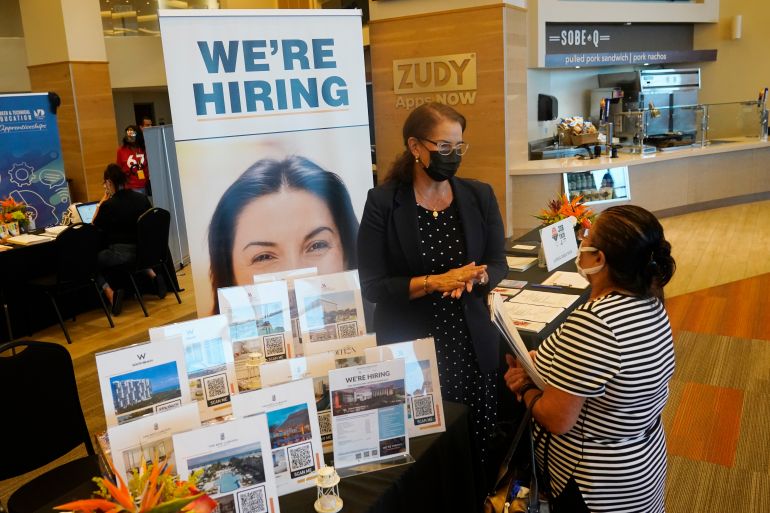US economy adds 467,000 jobs in January, calming Omicron fears
The United States economy added a better-than-expected 467,000 jobs last month, despite a wave of workers calling in sick as Omicron infections peaked.

Sometimes economic forecasters are too glum for their own good. That sure was the case on Friday with the release of the closely watched monthly US jobs report.
The United States economy added a robust 467,000 jobs in January, the US Department of Labor said on Friday. That was far, far better than most analysts were expecting and quells fears that the fast-spreading Omicron variant of COVID-19 temporarily dented the labour market recovery in the world’s largest economy.
Keep reading
list of 4 itemsPrepare for liftoff: Fed signals March interest rate hike
Inflation watch: US consumer prices see sharpest surge since 1982
Hot mic: Biden swears at Fox News reporter for inflation question
“The labor market started the year off on a stronger-than-expected note defying expectations that the rapid spread of Omicron would lead to a temporary pullback,” said Oxford Economics chief US economist Kathy Bostjancic in a note to clients.
The US jobs market also closed out 2021 on a stronger footing than first thought. Jobs creation for November and December last year were revised up by a combined 709,000.
The nation’s unemployment rate edged up slightly in January to 4 percent after falling to 3.9 percent in December. But it’s not as bad as it seems at first glance because the number of people either working or actively looking for a job – a metric called the labour force participation rate – increased to 62.2 percent, the highest level since the coronavirus pandemic struck in March 2020.
The bump suggests that workers are moving off the sidelines – a development that is likely to cheer business owners who are struggling to fill a near-record number of job openings and have been sweetening benefits and pay packages to lure scarce job seekers.
That enhanced worker bargaining power was on display in average hourly earnings, which climbed 5.7 percent in December compared to the same period a year ago.
But as earnings go up, it further stokes inflation, which is also being fed by ongoing supply-chain disruptions and shortages of raw materials. That double whammy increases input costs for businesses, and they are increasingly passing on at least a portion of that financial burden to consumers.
That’s why the January jobs report falls at a critical juncture in the nation’s economic recovery.
US inflation is running at its hottest level in nearly 40 years and those higher prices erode purchasing power – undercutting the windfall from fatter paycheques.
Soaring costs for essentials like food, gasoline, and rent are also especially hard on low-income households that are forced to shell out a larger share of their financial resources to cover those basic needs.
Finally, too much inflation is bad for consumer confidence, which is bad for the economy. Because when consumers don’t feel good about their financial fortunes and prospects, it saps their spending mojo – and consumer spending drives some two-thirds of US economic growth.
Cue the Fed
For most of the recovery, the steward of the US economy, the Federal Reserve, has kept interest rates low to encourage jobs creation.
But late last year, with job openings abounding and inflation soaring, the Fed signalled a hard pivot away from job-boosting easy money policies and towards raising borrowing costs to keep a lid on rising prices.
Fed chief Jerome Powell said in January that the Fed will likely start raising interest rates in March. What’s more – he said that there is “quite a bit of room to raise interest rates without threatening the labour market”.
The Fed has a dual mandate to achieve maximum employment while keeping inflation under control. And right now inflation is running far above the Fed’s target rate of 2 percent.
The Fed insists there are no signs yet of a dreaded “wage-price spiral” – that’s when workers keep asking for a raise to keep up with inflation, feeding consumer demand for goods and services, which raises prices further.
If labour force participation continues to increase, it should help calm wage pressures. And Fed policymakers still think inflation will start to moderate later this year.
But the January jobs report is bound to fuel mounting speculation that the Fed could hike rates by as much as half a percentage point in March, or signal a more aggressive tightening cycle ahead.